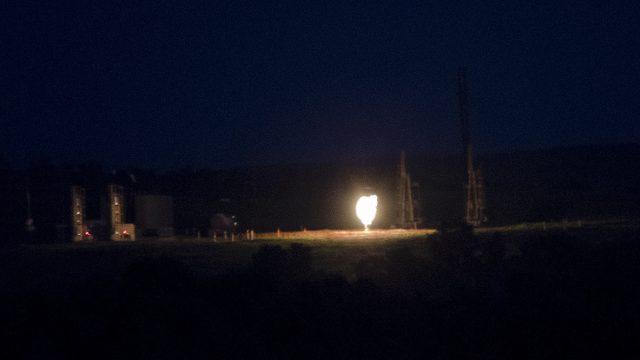Let's Give The North Dakota Oil Industry Some Much Deserved Credit On Flaring

Yesterday at a meeting of the North Dakota Industrial Commission – the regulatory triumvirate which oversees oil and gas development in North Dakota – the oil industry asked that flaring goals created by the state be pushed back.
Starting on October 1 of 2016 the oil industry can flare no more than 15 percent of gas produced, with the goal of getting that number down to 10 percent by 2020. Wells not coming in at or below that benchmark face heavy restrictions on the amount of oil they can produce.
The oil industry says they’ve had major obstacles in building the capacity to capture more gas and want the benchmark pushed back. Regulators were skeptical of the request:
Dalrymple reiterated the need for industry to clearly document its problems justifying the delay.
“Otherwise, we just lose a lot of credibility with this,” Dalrymple said.
But before anyone accuses the industry of trying to skirt flaring limits, let’s appreciate the enormous amount of work they’ve done to fix the flaring problem to date.
Because it really is amazing.
For one thing, since July of 2014 when the Industrial Commission first instituted these new flaring rules, the oil industry has reduced flaring from 26 percent to 17 percent, continuing a downward trend which had already begun before the regulators acted:
That’s a remarkable amount of progress, but percentages can be misleading so let’s look at the actual volumes of gas captured and flared. Again, since the new flaring regulations were put in place in July of last year, the amount of gas produced in the state has increased 23 percent – “The volume of gas is about 20 percent higher than projections when the rules were put in place,” reports the Bismarck Tribune – yet the amount of gas captured has increased 35 percent resulting in a 15 percent reduction in the actual volume of gas being flared.
Here are the trend lines for gas produced, captured, and flared in the state since 2012:
So the oil industry has managed to increase the amount of gas they’ve captured faster than the increases in the amount of gas produced, even though the increase in gas produced was way above projections.
That sure sounds like an industry making a good-faith effort to address this problem. But the industry also doesn’t feel like they can hit their goals, as the Bismarck Tribune reports:
Helms said problems with major infrastructure projects coming online as well as delays in attaining permits and right-of-way for easements have cropped up for industry. Pressure on industry and infrastructure has also built up as operators centered their operations into the most productive portion of the state’s oil play following a decline in oil prices.
“They see it as essentially impossible,” Helms said. “It really does call for an across-the-board modification of some kind I think.”
Also complicating matters is the fact that the state’s new conditioning regulations, aimed at addressing concerns over the volatility of Bakken crude shipped by rail, results in more gas being produced which must be captured and not flared.
Yet, again, the industry is reducing flaring. It doesn’t seem unreasonable then, given the progress that’s been made, to push back benchmarks.






